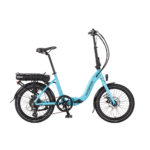IMPORTANT ETRA proposals 2
Proposals
1) As for cycles with pedal assistance excluded from the scope of Directive 2002/24/EC:
On behalf of the industry, ETRA proposes to change the current definition, which is as follows:
“cycles with pedal assistance which are equipped with an auxiliary electric motor having a maximum continuous rated power of 0.25 kilowatts, of which the output is progressively reduced and finally cut off as the vehicle reaches a speed of 25 km/h, or sooner, if the cyclist stops pedalling.”
Into the following new definition
“cycles with pedal assistance which are equipped with one or more auxiliary electric motors having a combined maximum continuous rated power of 0.50 kilowatts, of which the output is cut off as the vehicle reaches a speed of 25 km/h, or sooner, if the cyclist stops pedalling. Such cycles shall not be considered motor vehicles.”
Motivation:
Addition of “one or more” in order to facilitate the development of vehicles with more than one motor. This provision opens a lot more technical possibilities, for instance cargo/transport vehicles or three-wheelers for physically impaired with a small motor providing a very high torque for the riding off phase and a main motor to assist the pedalling.
Addition of “combined”: is the logical result of adding the provision “one or more”
Increase of the maximum continuous rated power from 0.25 to 0.50 kilowatts: as explained above, pedal assisted bicycles are now appealing to a much broader and more varied public throughout Europe. This development however shows that 0.25 kilowatts is not always sufficient to produce comfortable and safe electric bicycles that perform at the required level. The current power limit proves to be insufficient, for instance in hilly and mountainous areas, for people suffering from obesity, for three-wheelers developed for physically impaired people, for vehicles developed to transport cargo, … The increase of the power will have no negative effect on the safety of the currently best-selling bicycles because in that instance safety is mainly linked to the speed, for which this proposal holds no change. For cycles used in the above-mentioned conditions, the increase of power will have a positive effect on the safety because it will provide the cyclists far more reliability. Since the cyclist can rely on a cycle that in all conditions will perform at the required level, he will also enjoy more safety and comfort.
The Chairman of CEN TC333 “Cycles”, Mr Siegfried Neuberger has attended the meetings at which these proposals were developed. Together with the industry, he confirmed that a CEN standard for excluded pedal assisted bicycles with a maximum continuous rated power of 0.50 kilowatts can effectively provide the required level of product safety. For that purpose, the current standard EN 15194 could be reviewed and adapted to the new requirement in the type-approval legislation.
Deletion of “progressively reduced and finally”: the industry unanimously agrees that this requirement has no use. Since the requirement is not further specified, the industry currently does not know how to comply with it. The characteristic line of the motor management is a complex combination of pedalling frequency, actual speed and pedalling power. The essential requirement in the definition to ensure safe use of the vehicle is that the motor is cut off at 25 km/h. The requirement of progressive reduction has no bearing whatsoever on the safe use of the vehicle. This is the reason why we propose to delete the above-mentioned words.
Addition of “such cycles shall not be considered motor vehicles”: this provision should result in absolute clarity as to which vehicles are subject to type-approval and which are not. Today, at least one member state has introduced additional requirements for excluded pedal assisted cycles, which have resulted in a legal vacuum. This can be prevented by means of the proposed addition.
As for cycles with pedal assistance not excluded from the scope of Directive 2002/24/EC:
On behalf of the industry, ETRA proposes the introduction of a new category as a subdivision of the current category L “mopeds”. This new category would be defined as follows:
“Cycles with pedal assistance which are equipped with one or more auxiliary electric motors having a combined maximum continuous rated power not exceeding 1 kilowatts, of which the output is cut off as the vehicle reaches a speed of 45 km/h, or sooner, if the cyclist stops pedalling.”
Motivation:
A growing number of consumers show an interest in pedal assisted cycles with higher performances to replace the car for commuting, for utilitarian purposes (for instance pedalled taxis), for sportive use (for instance pedal assisted mountain bikes), etc. The industry believes that a separate category for these vehicles in combination with an appropriate type-approval will allow this market to achieve its full potential. It will facilitate the development of the products as well as putting them in the market. This category will provide legal certainty, whereas improved efficiencies will bring about a reduction of type-approval costs.
For this category the industry is prepared and ready to define the components and characteristics that will need to be submitted to type-approval as well as to develop the testing procedures for those components and characteristics.
As for cycles and low-performance mopeds with an electric motor:
Low-performance mopeds are currently defined by means of a note to Annex I. The definition is as follows:
“Low-performance mopeds, i.e. mopeds with pedals, with an auxiliary engine of power not exceeding 1 kW and a maximum design speed not exceeding 25 km/h”
On behalf of the industry, ETRA proposes the introduction of a new category as a subdivision of the current category L “Mopeds”. This category would be defined as follows:
“Cycles and mopeds with one or more electric motors of combined power not exceeding 1 kW and a maximum design speed not exceeding 25 km/h.”
Motivation:
A booming market stimulates technical development and product innovation. Quite a number of completely new vehicles cannot be classified under the current legislation, because that still pertains to the traditional mopeds. In Annex 2 are images of some of these vehicles. The market introduction of these vehicles is severely obstructed by the legal void.
The industry believes that a separate category for these vehicles in combination with an appropriate type-approval will allow this market to achieve its full potential. It will facilitate the development of the products as well as putting them in the market. This category will provide legal certainty, whereas improved efficiencies will bring about a reduction of type-approval costs.
At the same time, this category will cover all cycles equipped with an auxiliary electric motor that can propel the vehicle by itself.
For this category the industry is prepared to define the components and characteristics that will need to be submitted to type-approval as well as to develop the testing procedures for those components and characteristics.
Proposals
1) As for cycles with pedal assistance excluded from the scope of Directive 2002/24/EC:
On behalf of the industry, ETRA proposes to change the current definition, which is as follows:
“cycles with pedal assistance which are equipped with an auxiliary electric motor having a maximum continuous rated power of 0.25 kilowatts, of which the output is progressively reduced and finally cut off as the vehicle reaches a speed of 25 km/h, or sooner, if the cyclist stops pedalling.”
Into the following new definition
“cycles with pedal assistance which are equipped with one or more auxiliary electric motors having a combined maximum continuous rated power of 0.50 kilowatts, of which the output is cut off as the vehicle reaches a speed of 25 km/h, or sooner, if the cyclist stops pedalling. Such cycles shall not be considered motor vehicles.”
Motivation:
Addition of “one or more” in order to facilitate the development of vehicles with more than one motor. This provision opens a lot more technical possibilities, for instance cargo/transport vehicles or three-wheelers for physically impaired with a small motor providing a very high torque for the riding off phase and a main motor to assist the pedalling.
Addition of “combined”: is the logical result of adding the provision “one or more”
Increase of the maximum continuous rated power from 0.25 to 0.50 kilowatts: as explained above, pedal assisted bicycles are now appealing to a much broader and more varied public throughout Europe. This development however shows that 0.25 kilowatts is not always sufficient to produce comfortable and safe electric bicycles that perform at the required level. The current power limit proves to be insufficient, for instance in hilly and mountainous areas, for people suffering from obesity, for three-wheelers developed for physically impaired people, for vehicles developed to transport cargo, … The increase of the power will have no negative effect on the safety of the currently best-selling bicycles because in that instance safety is mainly linked to the speed, for which this proposal holds no change. For cycles used in the above-mentioned conditions, the increase of power will have a positive effect on the safety because it will provide the cyclists far more reliability. Since the cyclist can rely on a cycle that in all conditions will perform at the required level, he will also enjoy more safety and comfort.
The Chairman of CEN TC333 “Cycles”, Mr Siegfried Neuberger has attended the meetings at which these proposals were developed. Together with the industry, he confirmed that a CEN standard for excluded pedal assisted bicycles with a maximum continuous rated power of 0.50 kilowatts can effectively provide the required level of product safety. For that purpose, the current standard EN 15194 could be reviewed and adapted to the new requirement in the type-approval legislation.
Deletion of “progressively reduced and finally”: the industry unanimously agrees that this requirement has no use. Since the requirement is not further specified, the industry currently does not know how to comply with it. The characteristic line of the motor management is a complex combination of pedalling frequency, actual speed and pedalling power. The essential requirement in the definition to ensure safe use of the vehicle is that the motor is cut off at 25 km/h. The requirement of progressive reduction has no bearing whatsoever on the safe use of the vehicle. This is the reason why we propose to delete the above-mentioned words.
Addition of “such cycles shall not be considered motor vehicles”: this provision should result in absolute clarity as to which vehicles are subject to type-approval and which are not. Today, at least one member state has introduced additional requirements for excluded pedal assisted cycles, which have resulted in a legal vacuum. This can be prevented by means of the proposed addition.
As for cycles with pedal assistance not excluded from the scope of Directive 2002/24/EC:
On behalf of the industry, ETRA proposes the introduction of a new category as a subdivision of the current category L “mopeds”. This new category would be defined as follows:
“Cycles with pedal assistance which are equipped with one or more auxiliary electric motors having a combined maximum continuous rated power not exceeding 1 kilowatts, of which the output is cut off as the vehicle reaches a speed of 45 km/h, or sooner, if the cyclist stops pedalling.”
Motivation:
A growing number of consumers show an interest in pedal assisted cycles with higher performances to replace the car for commuting, for utilitarian purposes (for instance pedalled taxis), for sportive use (for instance pedal assisted mountain bikes), etc. The industry believes that a separate category for these vehicles in combination with an appropriate type-approval will allow this market to achieve its full potential. It will facilitate the development of the products as well as putting them in the market. This category will provide legal certainty, whereas improved efficiencies will bring about a reduction of type-approval costs.
For this category the industry is prepared and ready to define the components and characteristics that will need to be submitted to type-approval as well as to develop the testing procedures for those components and characteristics.
As for cycles and low-performance mopeds with an electric motor:
Low-performance mopeds are currently defined by means of a note to Annex I. The definition is as follows:
“Low-performance mopeds, i.e. mopeds with pedals, with an auxiliary engine of power not exceeding 1 kW and a maximum design speed not exceeding 25 km/h”
On behalf of the industry, ETRA proposes the introduction of a new category as a subdivision of the current category L “Mopeds”. This category would be defined as follows:
“Cycles and mopeds with one or more electric motors of combined power not exceeding 1 kW and a maximum design speed not exceeding 25 km/h.”
Motivation:
A booming market stimulates technical development and product innovation. Quite a number of completely new vehicles cannot be classified under the current legislation, because that still pertains to the traditional mopeds. In Annex 2 are images of some of these vehicles. The market introduction of these vehicles is severely obstructed by the legal void.
The industry believes that a separate category for these vehicles in combination with an appropriate type-approval will allow this market to achieve its full potential. It will facilitate the development of the products as well as putting them in the market. This category will provide legal certainty, whereas improved efficiencies will bring about a reduction of type-approval costs.
At the same time, this category will cover all cycles equipped with an auxiliary electric motor that can propel the vehicle by itself.
For this category the industry is prepared to define the components and characteristics that will need to be submitted to type-approval as well as to develop the testing procedures for those components and characteristics.
Last edited:






